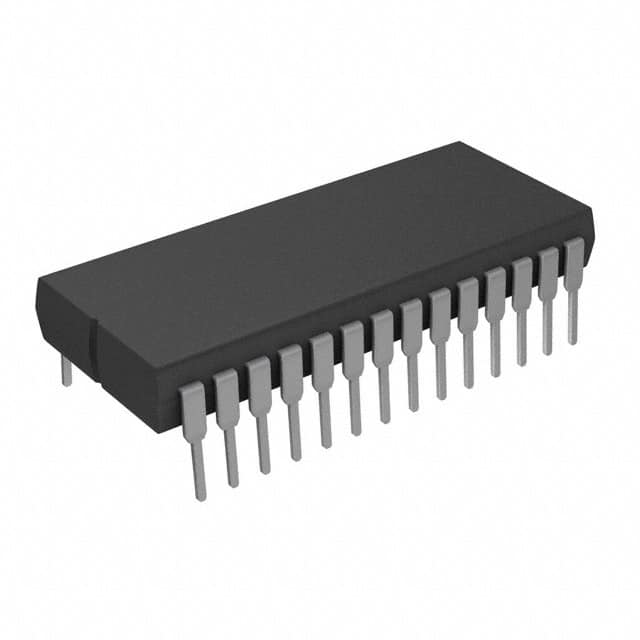AT28C256E-25DM/883
Product Overview
Category: Integrated Circuit (IC)
Use: The AT28C256E-25DM/883 is a high-performance electrically erasable and programmable read-only memory (EEPROM) IC. It is commonly used for non-volatile storage of data in various electronic devices.
Characteristics: - High-density storage capacity - Fast read and write operations - Low power consumption - Wide operating voltage range - Durable and reliable
Package: The AT28C256E-25DM/883 is available in a 28-pin Dual Inline Package (DIP), which provides easy integration into circuit boards.
Essence: This EEPROM IC allows for the storage and retrieval of digital information even when the power supply is disconnected. It offers a reliable and efficient solution for non-volatile data storage requirements.
Packaging/Quantity: The AT28C256E-25DM/883 is typically packaged in tubes or trays, with each package containing a specified quantity of ICs.
Specifications
- Storage Capacity: 256 kilobits (32 kilobytes)
- Operating Voltage Range: 4.5V to 5.5V
- Access Time: 250 ns
- Operating Temperature Range: -40°C to +85°C
- Data Retention: 10 years
- Endurance: 100,000 write cycles
Pin Configuration
The AT28C256E-25DM/883 features a 28-pin configuration. The pinout diagram is as follows:
__ __
A16 |1 28| Vcc
A12 |2 27| A15
A7 |3 26| A14
A6 |4 25| A13
A5 |5 24| A8
A4 |6 23| A9
A3 |7 22| A11
A2 |8 21| OE#
A1 |9 20| CE#
A0 |10 19| WE#
GND |11 18| I/O0
NC |12 17| I/O1
NC |13 16| I/O2
NC |14 15| I/O3
-- --
Functional Features
- Electrically erasable and programmable memory
- Non-volatile data storage
- High-speed read and write operations
- Low power consumption
- Easy integration into electronic circuits
Advantages and Disadvantages
Advantages: - High-density storage capacity - Fast access time - Wide operating voltage range - Durable and reliable - Suitable for various applications
Disadvantages: - Limited endurance (100,000 write cycles) - Relatively higher cost compared to other memory technologies
Working Principles
The AT28C256E-25DM/883 utilizes a combination of electrically controlled gates and floating gate transistors to store and retrieve digital information. The stored data can be erased and reprogrammed using specific electrical signals.
Detailed Application Field Plans
The AT28C256E-25DM/883 is widely used in various electronic devices and systems, including but not limited to: - Microcontrollers - Embedded systems - Communication equipment - Automotive electronics - Industrial control systems
Alternative Models
Other alternative models that offer similar functionality to the AT28C256E-25DM/883 include: - AT28C256-15PU - AT28C256-20PC - AT28C256-25PI - AT28C256-30DM/883
These alternative models may have different specifications and package options, but they serve the same purpose of non-volatile data storage.
In conclusion, the AT28C256E-25DM/883 is a high-performance EEPROM IC that provides reliable and efficient non-volatile data storage. With its wide range of applications and functional features, it serves as an essential component in various electronic devices and systems.
Lista 10 Vanliga frågor och svar relaterade till tillämpningen av AT28C256E-25DM/883 i tekniska lösningar
Question: What is the maximum operating frequency of AT28C256E-25DM/883?
Answer: The maximum operating frequency of AT28C256E-25DM/883 is 25MHz.Question: What is the voltage range for programming AT28C256E-25DM/883?
Answer: AT28C256E-25DM/883 can be programmed with a voltage range of 4.5V to 5.5V.Question: Can AT28C256E-25DM/883 be used in automotive applications?
Answer: Yes, AT28C256E-25DM/883 is suitable for automotive applications as it meets the AEC-Q100 standard.Question: What is the typical access time of AT28C256E-25DM/883?
Answer: The typical access time of AT28C256E-25DM/883 is 90ns.Question: Is AT28C256E-25DM/883 compatible with industrial temperature ranges?
Answer: Yes, AT28C256E-25DM/883 is designed to operate within the industrial temperature range of -40°C to 85°C.Question: Does AT28C256E-25DM/883 support in-system programming (ISP)?
Answer: No, AT28C256E-25DM/883 does not support in-system programming.Question: What is the maximum data retention period of AT28C256E-25DM/883?
Answer: AT28C256E-25DM/883 has a maximum data retention period of 10 years.Question: Can AT28C256E-25DM/883 be used in battery-powered devices?
Answer: Yes, AT28C256E-25DM/883 is suitable for use in battery-powered devices due to its low power consumption.Question: What is the package type of AT28C256E-25DM/883?
Answer: AT28C256E-25DM/883 is available in a 28-lead ceramic dual in-line package (CDIP).Question: Is AT28C256E-25DM/883 RoHS compliant?
Answer: Yes, AT28C256E-25DM/883 is RoHS compliant, making it suitable for use in environmentally sensitive applications.


